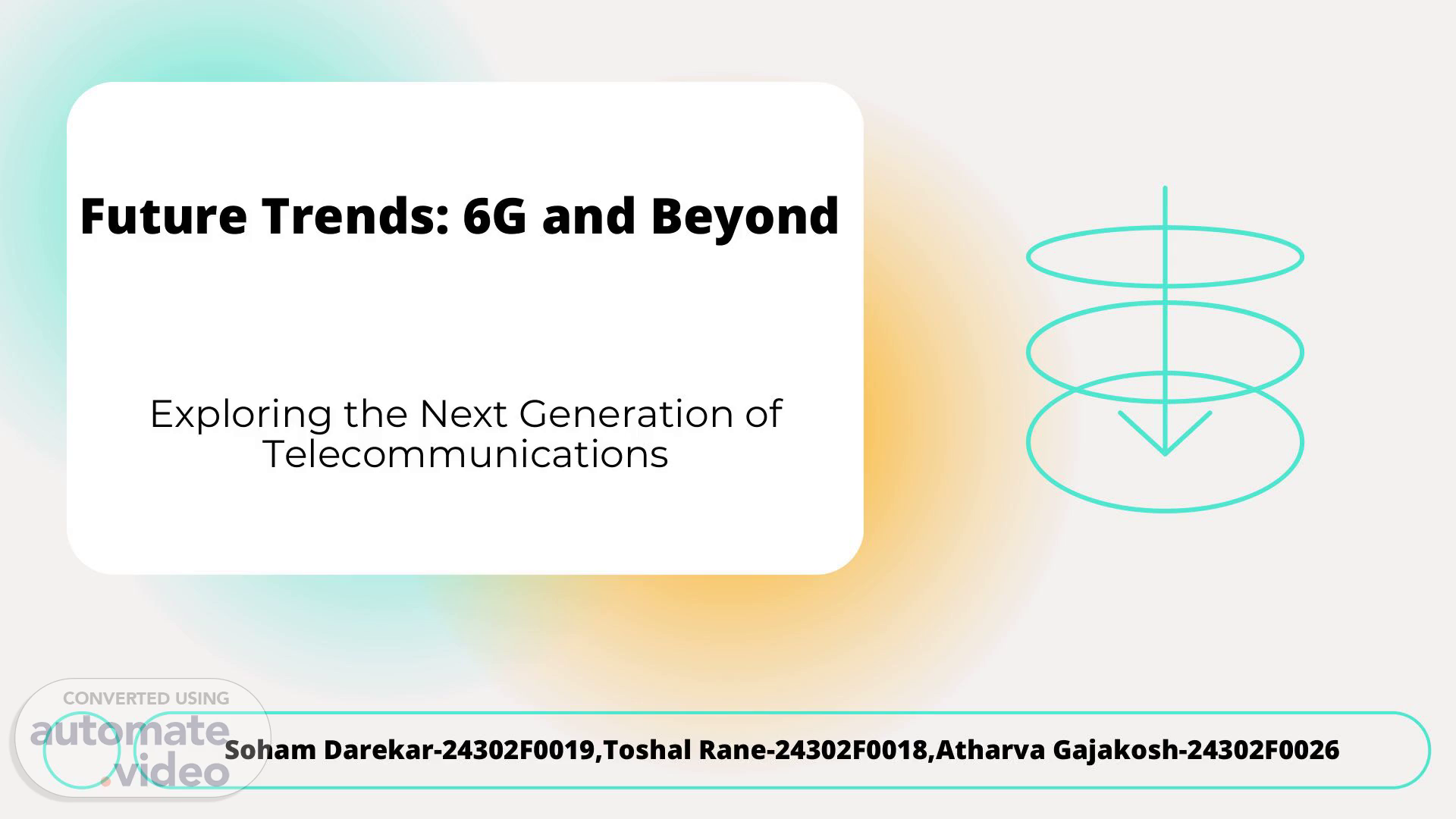Scene 1 (0s)
Soham Darekar-24302F0019,Toshal Rane-24302F0018,Atharva Gajakosh-24302F0026 Future Trends: 6G and Beyond Exploring the Next Generation of Telecommunications.
Scene 2 (9s)
Introduction to 6G The sixth generation (6G) of wireless technology will be the successor to 5G, projected to launch by 2030. 6G will focus on extreme performance improvements in speed, latency, and connectivity. What is 6G? Why is it needed? Current trends in augmented reality (AR), virtual reality (VR), AI, and IoT will require faster, more reliable, and efficient networks. 6G aims to address the growing demands of data consumption and provide more comprehensive, scalable services globally..
Scene 3 (31s)
Extreme Data speeds KEY FEATURES OF 6G Speeds up to 1 Terabit per second (Tbps), 100x faster than 5G, will support advanced applications such as high-resolution holographic conferencing. Ultra-low Latency 6G’s latency is expected to be in microseconds (as low as 0.1 ms), enabling critical applications like remote surgeries, autonomous vehicles, and real-time control systems. Massive Connectivity 6G will support an ultra-dense network of IoT devices, sensors, and connected systems – up to 10 million devices per square kilometer. AI-Powered Networks AI will be integral to managing network complexity, predicting system failures, optimizing bandwidth, and ensuring network security..
Scene 4 (58s)
TECHNOLOGY DRIVING 6G Terahertz (THz) Frequencies: Advanced MIMO: Quantum Communication: Utilizing frequencies between 100 GHz to 3 THz, these high-bandwidth waves will support the incredible data rates required for 6G. However, challenges with range and penetration need to be overcome. Massive MIMO (Multiple Input Multiple Output) technology will allow 6G to handle hundreds or even thousands of antennas for improved capacity and coverage. Emerging quantum technologies may help create highly secure communication channels, using quantum encryption to protect data at unprecedented levels..
Scene 5 (1m 18s)
POTENTIAL APPLICATION OF 6G Holographic Communication 6G will make it possible to transmit 3D holograms in real time, revolutionizing video entertainment by adding new layers of immersion. AI-driven Autonomous Systems Immersive AR/VR Smart Cities & IoT Real-time AI models operating over 6G networks could enable fully autonomous vehicles, drones, and smart robots capable of making decisions without human input Ultra-realistic AR/VR experiences with lifelike detail will enable applications in gaming, virtual tourism, remote education, and even professional training in environments like medicine. 6G will connect billions of smart sensors and devices, allowing city- wide automation, monitoring, and control systems – from traffic management to energy optimization..
Scene 6 (1m 46s)
CHALLENGES IN 6G DEVLOPMENT Energy Efficiency: With increased power demands from more data, new energy-efficient hardware and network designs will be necessary to prevent 6G from being unsustainable. Infrastructure Costs: Deployment of new infrastructure like THz-capable antennas and base stations will be a major financial challenge, especially in developing regions. Security Concerns: As networks grow and handle more critical tasks, the potential for cyberattacks rises. Advanced security protocols, including AI-based threat detection, will be crucial to protect 6G systems. Spectrum Availability: Allocating and managing higher-frequency bands like THz waves poses challenges due to limited spectrum availability and regulatory hurdles..
Scene 7 (2m 13s)
BEYOND 6G: THE FUTURE OF TELECOMMUNICATIONS 7G and Beyond: While 6G isn’t yet here, early thoughts on 7G suggest hyperconnectivity powered by satellite networks, where terrestrial and non-terrestrial networks (NTNs) work seamlessly. Digital Twins and Virtual Realities: 7G may integrate more with digital twins – exact virtual replicas of physical objects or environments, allowing for remote monitoring and interaction. • Biological Networks: The concept of bio-integrated networks might emerge, enabling networks that interface directly with the human body for medical or performance-enhancement purposes..
Scene 8 (2m 37s)
COMPARISON: 5G VS 6G • Data Speeds: • 5G: Up to 10 Gbps | 6G: Targeting up to 1 Tbps. • Latency: • 5G: ~1 ms | 6G: Sub-1 ms, aiming for microseconds (0.1 ms). • Connection Density: • 5G: 1 million devices per km² | 6G: 10 million devices per km². • AI and Automation: • 5G primarily focuses on low-latency and high-speed networks, while 6G will integrate AI more deeply to enable fully autonomous systems and optimize networks in real-time..
Scene 9 (3m 0s)
Impact on Society Economic Growth: • 6G is expected to open new industries and services, such as remote workspaces, real-time healthcare monitoring, and AI-driven automation, contributing trillions to global economies. Environmental Impact: • While 6G promises benefits, it could also increase energy consumption. A key focus will be developing eco-friendly technologies to reduce carbon emissions. Social Connectivity: • 6G’s high speed and reliability will support remote healthcare, education, and public services, improving the quality of life worldwide..
Scene 10 (3m 23s)
Conclusion 6G represents a leap forward in wireless communication technology, offering unprecedented data speeds, near-instantaneous response times, and seamless global connectivity. It will drive future innovations in AI, IoT, smart cities, and autonomous systems while addressing critical societal needs. However, significant challenges around energy use, infrastructure costs, and security must be overcome for 6G to realize its potential..
Scene 11 (3m 41s)
Thanks.
